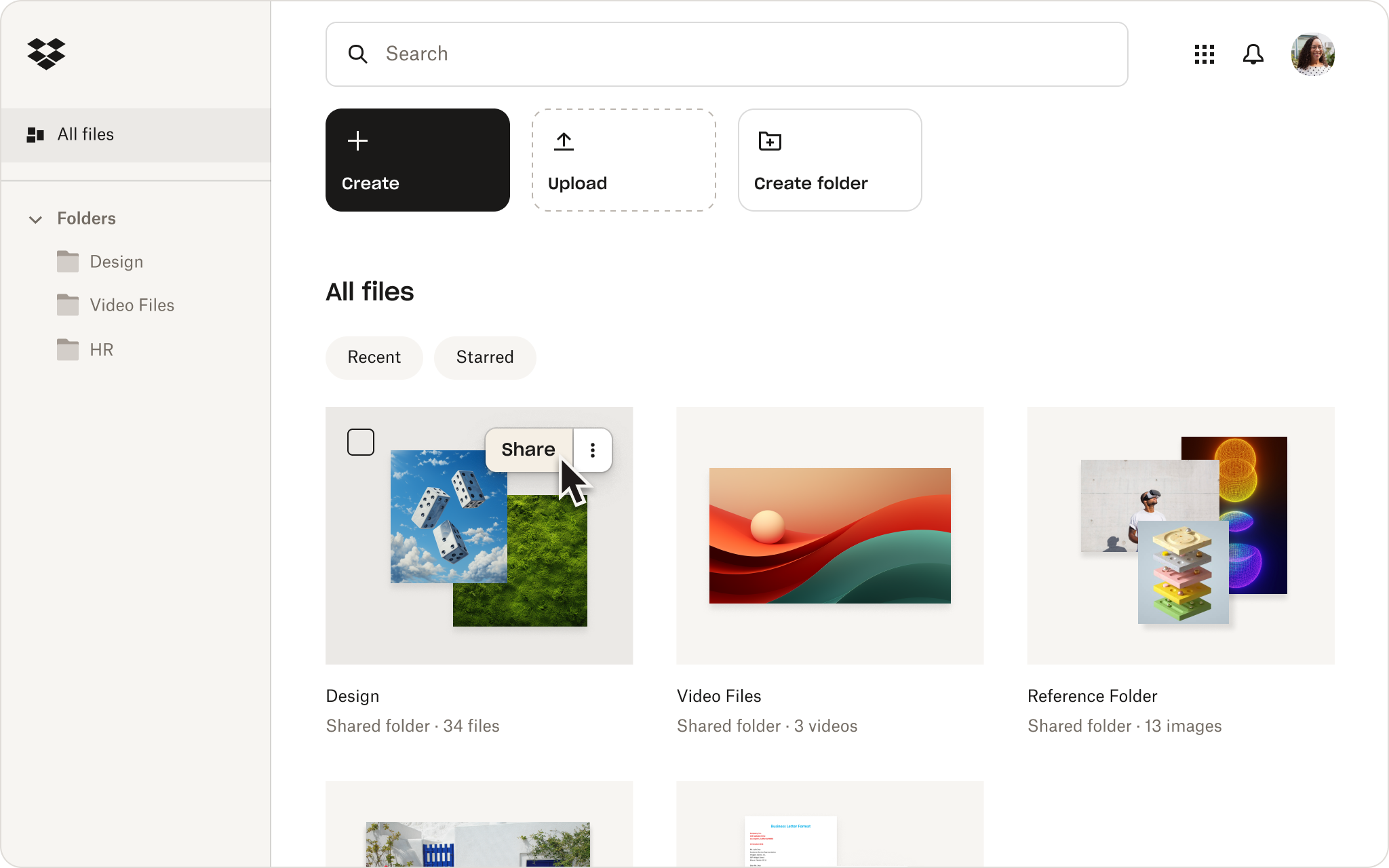Table of contents
- The art of selling: how and where to sell digital art online
- The challenge with digital art—and how to overcome it
- Can you make money from digital art?
- Types of digital art that are commonly sold online
- Where is the best place to sell digital art?
- How to help your digital art business thrive
- Streamline your digital art practice with Dropbox
The art of selling: How and where to sell digital art online
Digital art presents exciting opportunities for artists, designers, and illustrators—but can it be turned into a sustainable income stream? Whether you’re a solopreneur, freelance designer, or digital creator, this guide will walk you through the best ways to sell digital art online, covering platforms, pricing strategies, and business management tips.
Discover the best ways to sell digital art online, covering platforms, pricing strategies, and business management tips. But first, let’s look at how digital art differs from “traditional” art forms.
The challenge with digital art—and how to overcome it
It’s no secret that the art world—both physical and digital—is highly competitive. Yes, selling art online is a great way to make money, but it’s an industry that’s becoming increasingly crowded—so your work needs to stand out from the crowd.
If you create a priceless piece of hand-painted art that’s sold at auction, or a limited series of graphic design prints, you’re obviously selling a physical copy of the art. The buyer can then take the art home and enjoy ownership of it.
With digital art, as soon as your artwork is purchased the buyer can technically share and re-use it however they want.
This poses an interesting question:
How can digital art be valuable to buyers?
Well, there are a few ways to achieve this. In addition to producing work that’s high quality and reasonably priced, consider creating art that is:
- Useful assets—create downloadable graphic packs, templates, or design element
- Personalized commissions—offer custom illustrations or unique artwork tailored to individual clients
- Exclusive access—offer limited-edition prints or membership-only collections
Combining these approaches with a strong brand identity will help you build a loyal audience willing to invest in your work.

Can you make money from digital art?
Yes. There are multiple ways to monetize digital art, whether you’re looking for active income (freelancing, commissions) or passive income (selling design packs, templates, or stock graphics).
Key monetization strategies include:
- Custom commissions—work directly with clients to create personalized artwork
- Selling ready-made designs—upload and sell logos, vector graphics, social media templates, or fonts
- Stock art and design assets—create and sell Twitch emotes, UI kits, or branding elements
- Print-on-demand—offer artwork on t-shirts, phone cases, and posters
Each approach has its own advantages, and many digital artists combine multiple revenue streams to increase their earnings.
Types of digital art that are commonly sold online
Digital art is a broad umbrella term, under which is an enormous variety of different mediums and formats. Generally speaking, there are two routes to success with digital art:
- Finding a niche—find a creative community, movement, or emerging category of art with a sizable audience, but limited art in existence. In many cases, these audiences will be willing to pay more for niche pieces of art created by talented artists with particular skill sets or interests.
- Developing an iconic style—become known for your style, which emanates from all your works. Offer something that your competitors can’t, and that couldn’t be found anywhere other than through a commission directly from you.
In the next section, we’ll focus on the types of digital art that can be sold online, along with some of the different methods for selling digital art.
Commissions and original artwork
Commissioning art is when an artist creates a custom piece based on a client’s request. Individuals, businesses, organizations, and even governments can commission original artwork for personal or professional use.
Commissions are an excellent way to create valuable, unique, high-quality art for customers. They are getting a product for commercial or personal use that they couldn’t otherwise create or replicate.

Logos, vector graphics and design elements
As a simple way to earn passive income, you could create digital art prints to put on t-shirts, phone cases, stickers, and other physical products.
Or you could pivot to freelance design and create custom art or designs for brands. Every day, small businesses, content creators, and solopreneurs are creating new business opportunities. And each one needs support with branding their new project.
They may not be able to afford a full-time design agency, and may not have the expertise to produce branding kits in-house. Selling these as ready-made downloads or offering custom branding services can be profitable.
Fonts and typography designs
Similar to logos and vector graphics, web fonts can say a lot about a brand’s online presence. Developing custom fonts can be a lucrative business that reaches both professional designers and amateurs alike.
Social filters
Many of us will be familiar with the stylistic and AR filters for images and videos on social media. But did you know that you can make and sell custom filters, too?
Once created, custom filters are easy to sell via online marketplaces, allowing customers to download the file and import it into their in-app filter galleries.
Twitch emotes, animations, and badges
With the rise of live-streaming platforms like Twitch and YouTube, there is high demand for custom emotes, channel icons, and animations that make streamers stand out. These platforms frequently inspires viewers to try their hand at streaming for a shot at stream stardom.
Just as there is a market for logos in the small business and startup space, there is a large market for Twitch’s equivalent—badges, channel icons, custom chat emojis, and in-stream effects or animations.
3D print models and digital sculptures
3D printing is transforming how digital artists sell their work. Creators can sell 3D models for various things.
The possibilities are endless, but some examples include:
- Tabletop gaming miniatures and figurines
- Custom board game pieces
- Statues and other sculpture-like artwork
- Or anything you can think of—what about scale miniature models of famous mountain ranges, buildings, or a topographical map of the United States?
NFTs
NFTs, or “non-fungible tokens,” gained widespread attention in recent years and continue to be a topic of interest in digital art and collectibles. They aim to solve some of the biggest challenges with traditional and digital art—namely, provenance and reproduction.
With NFTs, a string of code and blockchain technology are used to create a form of digital receipt for the artwork. This shows that no matter how many copies exist, the listed person is the official owner of that digital artwork.
Unlike other digital art products, such as stickers and vector art, NFTs are generally limited-edition pieces. They’re sold on marketplaces, such as Opensea or Rarible, which handle the “minting” of the art and applying the block. This gives NFTs a unique quality and appeal as digital collectibles.
The emergence of this divisive medium has shaken up the art and cryptocurrency trading communities, with many initially treating it as a passing fad. While their long-term impact on the art industry is yet to be seen, the perceived value of NFTs is undeniable. In fact, the global NFT market size is expected to reach $92.98 billion by 2028.
Where is the best place to sell digital art?
Depending on the type of art you’re selling, you have a few options for how and where to sell your art. These include online marketplaces, bespoke quotes, and your own storefront.
Online marketplaces
Platforms like Etsy are becoming increasingly popular. They have the advantage of a wide customer base but are often oversaturated with a sea of competition and limited customization for sellers. In the case of NFTs, marketplaces form an integral part of the technology and experience.
Bespoke quotes
If you sell pieces at a higher value, you can always handle quotes directly and simply offer a means to contact and enquire for commissions or one-off pieces. You might manage this through direct messages through Instagram or other social media profiles.
Your own storefront
This may be a more expensive option, as providers such as Shopify require a subscription fee and a percentage per transaction.
However, creating your own storefront allows you to combine the simplified payment processing and management of marketplaces, with the uniqueness and customization of a more bespoke solution. The end result? A digital art gallery, open for business.

How to help your digital art business thrive
Once you start creating your art and have your storefront set up, it’s time to start driving customers to your online gallery and converting them into sales.
Pricing your work
Anyone involved in the art market will tell you that putting a price on a piece of art can be challenging. The pricing for digital artwork is slightly different from physical products.
With a print on canvas, for example, you would need to consider factors such as the materials, frame, shipping costs, and labor. For digital art, you’ll only need to think about the effort and time investment it took you to create the piece.
If you’re selling something tangible and practical, like design assets or 3D print models, then market research can help you understand demand, and what similar items generally go for.
If you’re selling something more bespoke, conduct research into artists that reach similar audiences and see what they charge. You may find that pricing low at first will allow you to drum up some early business and acclaim—after this, you can increase your prices based on demand.
Marketing your art online
You can help your online business succeed by promoting your work in the places your audience regularly visits. A to-do list with a productivity tool like Dropbox Paper, can help you keep track of all of your marketing activities.
Social media will be instrumental in this. You’ll be able to connect with fellow artists and attract potential customers through your posts. Remember, many social media users consume content differently depending on the platform. For this reason, consider branching into different formats to showcase your work, such as:
- TikTok videos
- A curated Instagram account, with reels as well as regular image posts and carousels
- Twitter hashtags, so your work can be seen and shared by art accounts
- Reddit forums
- Pinterest boards
If you’re prominent on social media, you could even add “Commissions available” to your bio—with a link to your storefront wherever possible.
Manage your workflow
Running a small business online naturally means you're creating and managing lots of content. From agendas and marketing plans to invoices—Dropbox provides a safe, centralized space for creating, storing, and sharing your files.
If you're selling your digital art directly to your clients, you need a secure way to share those files. Dropbox cuts out the tedious process of downloading files and attaching them to emails—you can share large files directly from your account.
And when you use Dropbox, you get access to a range of other helpful features as well, like version history and file recovery, to ensure you can access previous versions of your work and never lose important files.
The last thing you want to happen is your art being stolen or plagiarized. With Dropbox, you can add watermarks to PDFs—so any listings on marketplaces or your storefront can’t be downloaded and used without your permission.
By using Dropbox, you can streamline your digital art workflow, improve productivity, and focus more on creating art rather than worrying about file management.

Streamline your digital art practice with Dropbox
Starting a digital art business can be tricky—but with Dropbox, managing your workload is much simpler.
Dropbox is the ideal solution for creating, storing, and sharing files. Keep everything in one place, protect your work, and easily share files with clients.


